The 3D Printing Metal Market is estimated to be valued at USD 6.9 billion in 2025 and is projected to reach USD 61.4 billion by 2035, registering a compound annual growth rate (CAGR) of 24.5% over the forecast period.
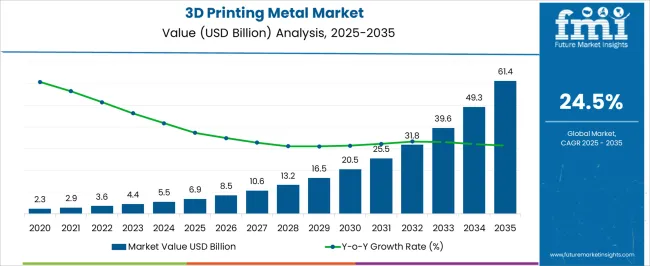
| Metric | Value |
|---|---|
| 3D Printing Metal Market Estimated Value in (2025 E) | USD 6.9 billion |
| 3D Printing Metal Market Forecast Value in (2035 F) | USD 61.4 billion |
| Forecast CAGR (2025 to 2035) | 24.5% |
The 3D Printing Metal market is gaining strong momentum as industries increasingly embrace additive manufacturing to reduce production costs, improve material efficiency, and enable design flexibility. Demand growth is being accelerated by sectors such as aerospace, automotive, healthcare, and defense, where lightweight, durable, and high-strength components are essential. Advancements in metal powders, process automation, and printer capabilities are enhancing production speed and part reliability, driving broader adoption across industrial ecosystems.
The cost reduction achieved through waste minimization and optimized supply chains is further supporting market expansion. Additionally, the ability to manufacture complex geometries that are not achievable through traditional manufacturing methods is boosting the adoption of metal 3D printing.
The rising integration of artificial intelligence and machine learning in print optimization, quality control, and predictive maintenance is shaping the future of this technology As companies seek sustainable, scalable, and innovative manufacturing solutions, the 3D Printing Metal market is positioned for long-term growth, supported by rapid advancements in materials science, manufacturing software, and high-precision printing technologies.
The 3d printing metal market is segmented by metal type, form, technology, and geographic regions. By metal type, 3d printing metal market is divided into Aluminum, Iron, Nickel, Tungsten, Titanium, Stainless Steel, and Others (Cobalt-Chrome, Copper, Silver, Gold, & Bronze). In terms of form, 3d printing metal market is classified into Powder and Filament. Based on technology, 3d printing metal market is segmented into Powder Bed Fusion, Directed Energy Deposition, Binder Jetting, Metal Extrusion, and Others (Digital Light Projector, Multi-Jet Fusion, And Material Jetting). Regionally, the 3d printing metal industry is classified into North America, Latin America, Western Europe, Eastern Europe, Balkan & Baltic Countries, Russia & Belarus, Central Asia, East Asia, South Asia & Pacific, and the Middle East & Africa.
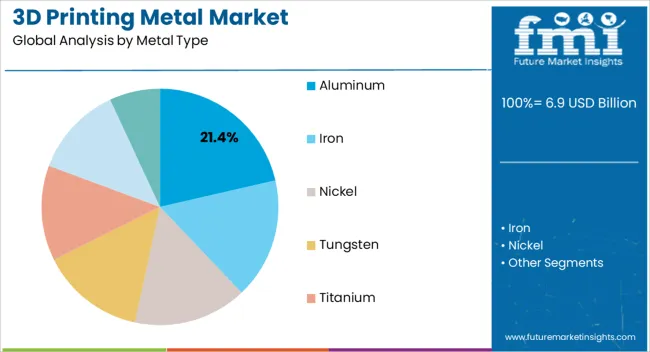
The aluminum segment is projected to account for 21.4% of the 3D Printing Metal market revenue in 2025, positioning it as a leading metal type. Growth is being driven by aluminum’s unique combination of lightweight properties, strength, and corrosion resistance, which makes it highly valuable in industries such as aerospace, automotive, and consumer electronics. The ability to reduce overall component weight without compromising durability is particularly advantageous in transportation sectors, where efficiency and sustainability goals are central.
Aluminum’s compatibility with a wide range of printing technologies ensures its flexibility for diverse applications, from prototypes to end-use parts. Additionally, aluminum alloys provide cost efficiency compared to more expensive metals such as titanium or nickel, making them an attractive choice for mid-range applications.
As research continues into developing high-performance aluminum powders optimized for additive manufacturing, this segment is expected to see sustained growth The increasing demand for lightweight structures, coupled with technological advancements in powder formulation and printing methods, is solidifying aluminum’s role as a critical contributor to market expansion.
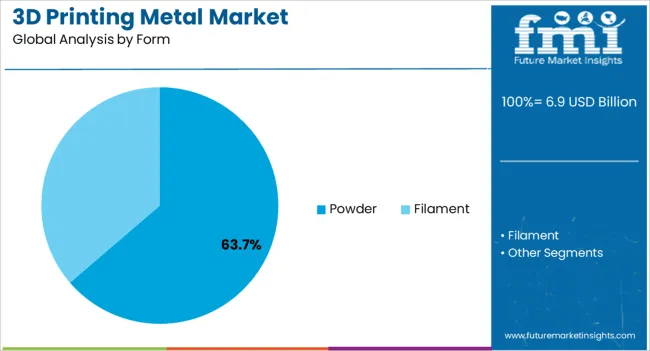
The powder form segment is anticipated to hold 63.7% of the market revenue share in 2025, making it the dominant form. This leadership is attributed to the widespread adoption of powder-based additive manufacturing, where powders provide the precision, uniformity, and flowability required for high-quality prints. Powder-based processes allow for accurate layering, which enables the production of complex and high-performance parts that meet stringent industrial standards.
The scalability of powder manufacturing supports mass production while maintaining consistency in quality, making it highly desirable for sectors such as aerospace, defense, and healthcare. Additionally, the recyclability of unused powders during the printing process helps reduce material waste, offering significant cost and sustainability benefits.
Continuous advancements in powder production methods, such as atomization and post-processing techniques, are improving powder quality and availability As industries increasingly prioritize precision engineering and sustainable manufacturing, the powder form segment is expected to retain its dominance, supported by innovations in material science and strong demand for reliable, high-strength 3D-printed metal components.
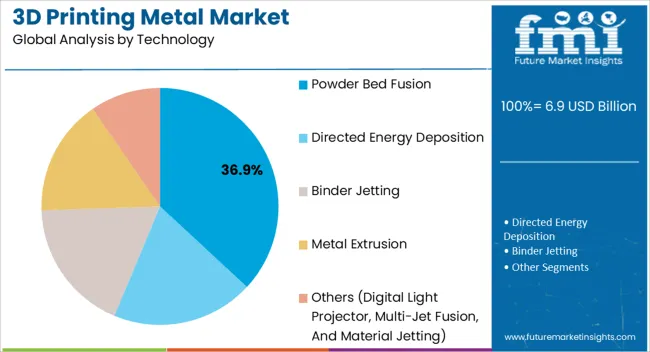
The powder bed fusion technology segment is projected to account for 36.9% of the 3D Printing Metal market revenue in 2025, making it the leading technology. Its dominance stems from its ability to produce highly detailed, durable, and complex metal components that meet stringent performance requirements. Powder bed fusion offers excellent precision and structural integrity, making it especially suitable for aerospace, medical implants, and industrial tooling applications.
The technology’s ability to create lightweight structures with optimized geometries supports industries focused on efficiency and sustainability. Advancements in machine design, laser systems, and in-situ monitoring are further improving the scalability, speed, and reliability of powder bed fusion systems. Additionally, the flexibility of the technology in working with different metal powders, including aluminum, titanium, and stainless steel, broadens its industrial applications.
Despite higher equipment costs compared to some alternatives, the return on investment through high-performance part production and reduced material waste reinforces its market position As demand for high-quality, production-ready components increases, powder bed fusion is expected to remain the cornerstone of the 3D Printing Metal market.
According to the latest market survey conducted by Future Market Insights, the global 3D Printing Metal market is relishing a market valuation of US$ 3,554.5 Million in 2025 and is all set to expand with a CAGR of 24.5% during the 2025 to 2035 period. The market is anticipated to top a valuation of US$ 31,803.0 Million by the end of the forecast period.
| Market Size 2025 | US$ 3,554.5 Million |
| Market Size 2035 | US$ 31,803.0 Million |
| Value CAGR (2025 to 2035) | 24.5% |
| Collective Value Share: Top 3 Countries (2025E) | 50% to 55% |
The industry for 3D printed metal products is still nascent and open to new entrants. It is estimated that 3D printing will account for around 0.1% of the global metal market. Nonetheless, gains of 25-30 basis points per share are anticipated by the end of the projected period.
The increasing need for rapid prototyping and cutting-edge manufacturing techniques has been great for the metal 3D printing industry. Increasing adoption of additive manufacturing across a wide range of sectors bodes well for the industry's future growth. In order to keep ahead of the competition, the worldwide industrial printer industry is trending toward consolidation.
The widespread usage of metal 3D printing across heavy industry applications is a major contributor to the market's expansion.
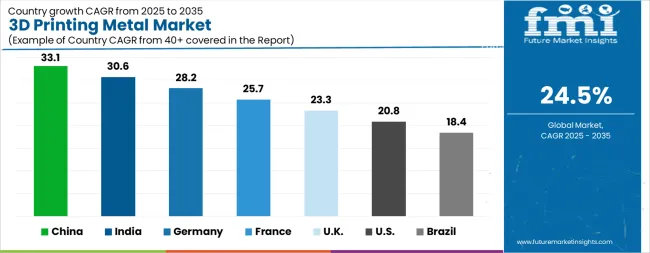
| Country | CAGR |
|---|---|
| China | 33.1% |
| India | 30.6% |
| Germany | 28.2% |
| France | 25.7% |
| UK | 23.3% |
| USA | 20.8% |
| Brazil | 18.4% |
The 3D Printing Metal Market is expected to register a CAGR of 24.5% during the forecast period, exhibiting varied country level momentum. China leads with the highest CAGR of 33.1%, followed by India at 30.6%. Developed markets such as Germany, France, and the UK continue to expand steadily, while the USA is likely to grow at consistent rates. Brazil posts the lowest CAGR at 18.4%, yet still underscores a broadly positive trajectory for the global 3D Printing Metal Market. In 2024, Germany held a dominant revenue in the Western Europe market and is expected to grow with a CAGR of 28.2%. The USA 3D Printing Metal Market is estimated to be valued at USD 2.3 billion in 2025 and is anticipated to reach a valuation of USD 15.5 billion by 2035. Sales are projected to rise at a CAGR of 20.8% over the forecast period between 2025 and 2035. While Japan and South Korea markets are estimated to be valued at USD 369.4 million and USD 216.3 million respectively in 2025.

| Item | Value |
|---|---|
| Quantitative Units | USD 6.9 Billion |
| Metal Type | Aluminum, Iron, Nickel, Tungsten, Titanium, Stainless Steel, and Others (Cobalt-Chrome, Copper, Silver, Gold, & Bronze) |
| Form | Powder and Filament |
| Technology | Powder Bed Fusion, Directed Energy Deposition, Binder Jetting, Metal Extrusion, and Others (Digital Light Projector, Multi-Jet Fusion, And Material Jetting) |
| Regions Covered | North America, Europe, Asia-Pacific, Latin America, Middle East & Africa |
| Country Covered | United States, Canada, Germany, France, United Kingdom, China, Japan, India, Brazil, South Africa |
| Key Companies Profiled | 3D Systems Inc., EOS GmbH, GE Additive, Renishaw PLC, SLM Solutions Group AG, HP Inc., Desktop Metal Inc., Markforged Inc., Trumpf GmbH + Co. KG, Velo3D Inc., AddUp SAS, Materialise NV, BeAM (AddUp), Farsoon Technologies, Bright Laser Technologies (BLT), Sintratec AG, Xact Metal, and Meltio |
The global 3D printing metal market is estimated to be valued at USD 6.9 billion in 2025.
The market size for the 3D printing metal market is projected to reach USD 61.4 billion by 2035.
The 3D printing metal market is expected to grow at a 24.5% CAGR between 2025 and 2035.
The key product types in 3D printing metal market are aluminum, iron, nickel, tungsten, titanium, stainless steel and others (cobalt-chrome, copper, silver, gold, & bronze).
In terms of form, powder segment to command 63.7% share in the 3D printing metal market in 2025.






Our Research Products

The "Full Research Suite" delivers actionable market intel, deep dives on markets or technologies, so clients act faster, cut risk, and unlock growth.

The Leaderboard benchmarks and ranks top vendors, classifying them as Established Leaders, Leading Challengers, or Disruptors & Challengers.

Locates where complements amplify value and substitutes erode it, forecasting net impact by horizon

We deliver granular, decision-grade intel: market sizing, 5-year forecasts, pricing, adoption, usage, revenue, and operational KPIs—plus competitor tracking, regulation, and value chains—across 60 countries broadly.

Spot the shifts before they hit your P&L. We track inflection points, adoption curves, pricing moves, and ecosystem plays to show where demand is heading, why it is changing, and what to do next across high-growth markets and disruptive tech

Real-time reads of user behavior. We track shifting priorities, perceptions of today’s and next-gen services, and provider experience, then pace how fast tech moves from trial to adoption, blending buyer, consumer, and channel inputs with social signals (#WhySwitch, #UX).

Partner with our analyst team to build a custom report designed around your business priorities. From analysing market trends to assessing competitors or crafting bespoke datasets, we tailor insights to your needs.
Supplier Intelligence
Discovery & Profiling
Capacity & Footprint
Performance & Risk
Compliance & Governance
Commercial Readiness
Who Supplies Whom
Scorecards & Shortlists
Playbooks & Docs
Category Intelligence
Definition & Scope
Demand & Use Cases
Cost Drivers
Market Structure
Supply Chain Map
Trade & Policy
Operating Norms
Deliverables
Buyer Intelligence
Account Basics
Spend & Scope
Procurement Model
Vendor Requirements
Terms & Policies
Entry Strategy
Pain Points & Triggers
Outputs
Pricing Analysis
Benchmarks
Trends
Should-Cost
Indexation
Landed Cost
Commercial Terms
Deliverables
Brand Analysis
Positioning & Value Prop
Share & Presence
Customer Evidence
Go-to-Market
Digital & Reputation
Compliance & Trust
KPIs & Gaps
Outputs
Full Research Suite comprises of:
Market outlook & trends analysis
Interviews & case studies
Strategic recommendations
Vendor profiles & capabilities analysis
5-year forecasts
8 regions and 60+ country-level data splits
Market segment data splits
12 months of continuous data updates
DELIVERED AS:
PDF EXCEL ONLINE
Market Positioning & Share in the 3D Printing Metal Industry
3D Imaging Surgical Solution Market Size and Share Forecast Outlook 2025 to 2035
3D Printed Dental Brace Market Size and Share Forecast Outlook 2025 to 2035
3D Reverse Engineering Software Market Forecast and Outlook 2025 to 2035
3D Automatic Optical Inspection Machine Market Size and Share Forecast Outlook 2025 to 2035
3D Ready Organoid Expansion Service Market Size and Share Forecast Outlook 2025 to 2035
3D-Printed Prosthetic Implants Market Size and Share Forecast Outlook 2025 to 2035
3D NAND Flash Memory Market Size and Share Forecast Outlook 2025 to 2035
3D Bioprinted Organ Transplants Market Size and Share Forecast Outlook 2025 to 2035
3D Mapping and Modeling Market Size and Share Forecast Outlook 2025 to 2035
3D Audio Market Size and Share Forecast Outlook 2025 to 2035
3D Printed Maxillofacial Implants Market Size and Share Forecast Outlook 2025 to 2035
3D Surgical Microscope Systems Market Size and Share Forecast Outlook 2025 to 2035
3D-Printed Personalized Masks Market Size and Share Forecast Outlook 2025 to 2035
3D Printed Packaging Market Size and Share Forecast Outlook 2025 to 2035
3D Printed Clear Dental Aligners Market Size and Share Forecast Outlook 2025 to 2035
3D IC and 2.5D IC Packaging Market Size and Share Forecast Outlook 2025 to 2035
3d-Printed Skincare Market Analysis - Size and Share Forecast Outlook 2025 to 2035
3D Display Market Size and Share Forecast Outlook 2025 to 2035
3D Neuroscience Market Size and Share Forecast Outlook 2025 to 2035

Thank you!
You will receive an email from our Business Development Manager. Please be sure to check your SPAM/JUNK folder too.
Chat With
MaRIA